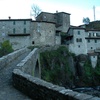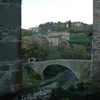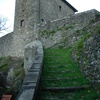Castle of San Michele
The village of San Michele stands austerely on a small hill on the right bank of the Acqua Bianca river, a particularly favourable position from which it was able to guard the valleys and the surrounding areas.
The fortifications of the village, built in mediaeval times, consist of a circuit wall - which supported dwellings - and a fortified house, the residence of the local lord. Despite contemporary extensions and renovations being carried out, the first fortified unit is well preserved and recognisable, dating from the twelfth century. In addition to these defences, the castle of San Michele could also count on a lookout tower on the hill to the south of the fort, of which today only a few stones remain. The stone bridge with a depressed arch that connects the two river banks also dates from the twelfth century and is still in very good condition.
The Castle Church dedicated to San Michele Arcangelo is difficult to date precisely: the first written record, in fact, dates back to 1584. Given the antiquity of the name, however, we must assume that this place of worship was already present in ancient times, erected before or in conjunction with construction of the castle.
Historical notes
The first evidence of the existence of this village is found on an ancient parchment from the year 883, with which Gherardo, Bishop of Lucca, gave the town of "Sala Episcopi" and all of its jurisdiction to the noble Cunemondo of San Michele. This was the origin of the Cunimondinghi, a noble lineage whose centre of power was in San Michele and Sala and it was for this reason that they were also recalled by the epithet of "nobiles de Sancti Machaeli". There had certainly been a castle in this area since the year 1110; the fort was mentioned again in 1122, but after the Cunimondinghi took part in the wars that shook the valley between the twelfth and thirteenth centuries, like many military outposts of the Garfagnana, it fell to the jurisdiction of the City of Lucca and was annexed to the Vicariate of Camporgiano.
In later centuries, it was the centre of continuing struggles that saw Lucca, Pisa, Florence and for a time even the Malaspina family oppose each other. So it was that for a long time the castle of San Michele remained faithful to Lucca; eventually, in 1445, together with the whole Vicariate of Camporgiano, it spontaneously gave itself to the Este family.











